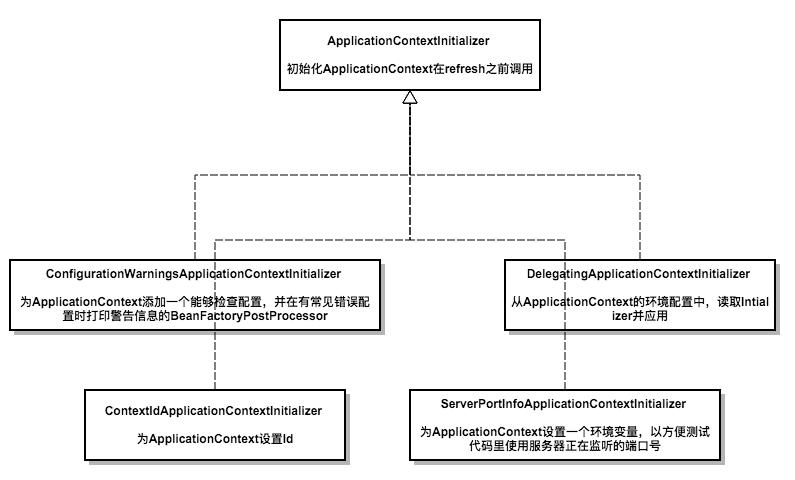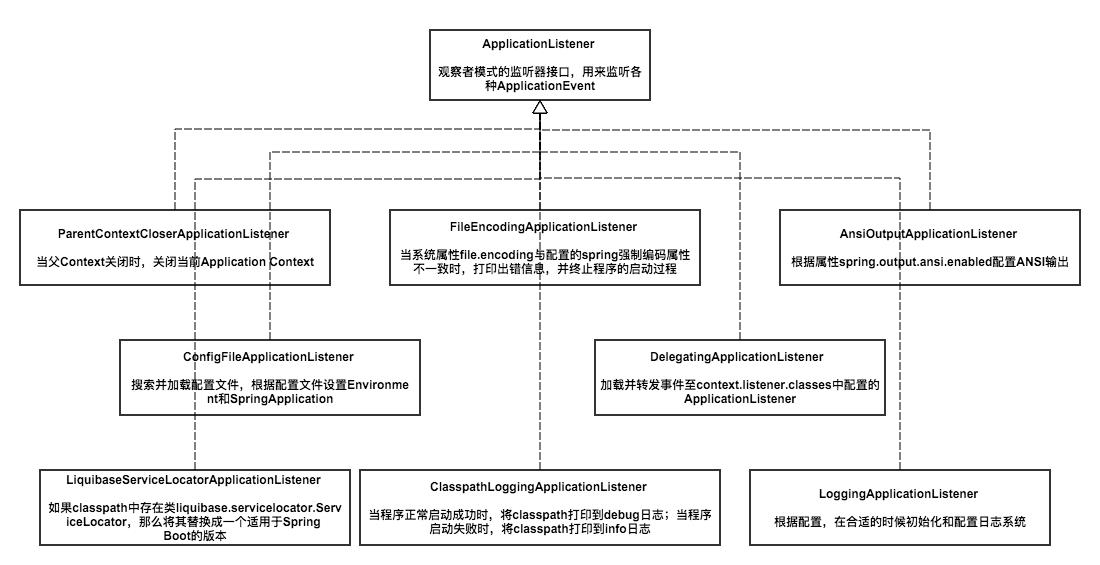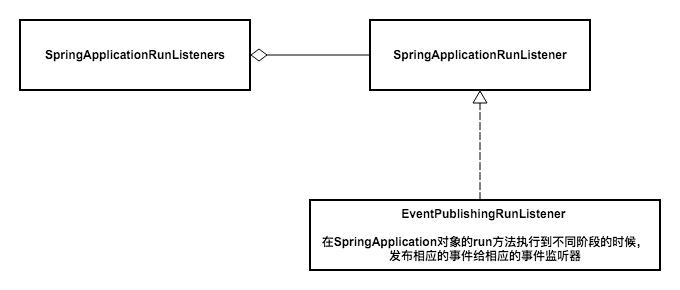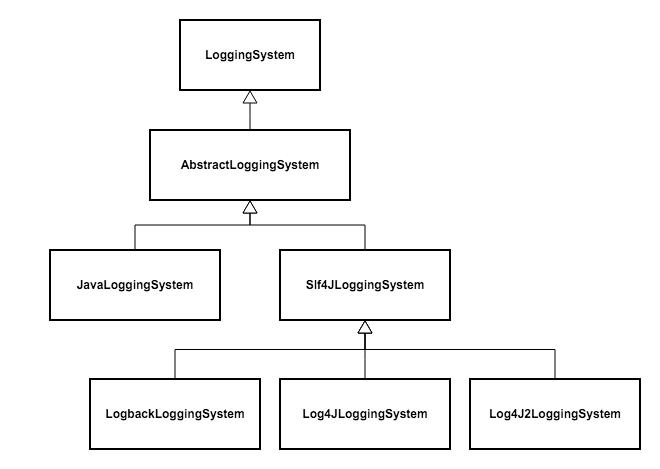Spring Boot启动流程详解
Posted Fly , Mason ! ! !
tags:
篇首语:本文由小常识网(cha138.com)小编为大家整理,主要介绍了Spring Boot启动流程详解相关的知识,希望对你有一定的参考价值。
环境
本文基于Spring Boot版本1.3.3, 使用了spring-boot-starter-web。
配置完成后,编写了代码如下:
@SpringBootApplication
public class Application {
public static void main(String[] args) {
SpringApplication.run(Application.class, args);
}
}
@RestController
public class RootController {
public static final String PATH_ROOT = "/";
@RequestMapping(PATH_ROOT)
public String welcome() {
return "Welcome!";
}
}
虽然只有几行代码,但是这已经是一个完整的Web程序,当访问url的path部分为"/"时,返回字符串"Welcome!"。
首先是一个非常普通的java程序入口,一个符合约定的静态main方法。在这个main方法中,调用了SpringApplication的静态run方法,并将Application类对象和main方法的参数args作为参数传递了进去。
然后是一个使用了两个Spring注解的RootController类,我们在main方法中,没有直接使用这个类。
SpringApplication类的静态run方法
以下代码摘自:org.springframework.boot.SpringApplicationpublic static ConfigurableApplicationContext run(Object source, String... args) {
return run(new Object[] { source }, args);
}
public static ConfigurableApplicationContext run(Object[] sources, String[] args) {
return new SpringApplication(sources).run(args);
}
在这个静态方法中,创建SpringApplication对象,并调用该对象的run方法。
构造SpringApplication对象
以下代码摘自:org.springframework.boot.SpringApplicationpublic SpringApplication(Object... sources) {
initialize(sources);
}
private void initialize(Object[] sources) {
// 为成员变量sources赋值
if (sources != null && sources.length > 0) {
this.sources.addAll(Arrays.asList(sources));
}
this.webEnvironment = deduceWebEnvironment();
setInitializers((Collection) getSpringFactoriesInstances(
ApplicationContextInitializer.class));
setListeners((Collection) getSpringFactoriesInstances(ApplicationListener.class));
this.mainApplicationClass = deduceMainApplicationClass();
}
构造函数中调用initialize方法,初始化SpringApplication对象的成员变量sources,webEnvironment,initializers,listeners,mainApplicationClass。sources的赋值比较简单,就是我们传给SpringApplication.run方法的参数。剩下的几个,我们依次来看看是怎么做的。
首先是webEnvironment:
以下代码摘自:org.springframework.boot.SpringApplicationprivate boolean webEnvironment;
private static final String[] WEB_ENVIRONMENT_CLASSES = { "javax.servlet.Servlet",
"org.springframework.web.context.ConfigurableWebApplicationContext" };
private void initialize(Object[] sources) {
...
// 为成员变量webEnvironment赋值
this.webEnvironment = deduceWebEnvironment();
...
}
private boolean deduceWebEnvironment() {
for (String className : WEB_ENVIRONMENT_CLASSES) {
if (!ClassUtils.isPresent(className, null)) {
return false;
}
}
return true;
}
可以看到webEnvironment是一个boolean,该成员变量用来表示当前应用程序是不是一个Web应用程序。那么怎么决定当前应用程序是否Web应用程序呢,是通过在classpath中查看是否存在WEB_ENVIRONMENT_CLASSES这个数组中所包含的类,如果存在那么当前程序即是一个Web应用程序,反之则不然。
在本文的例子中webEnvironment的值为true。
然后是initializers:
initializers成员变量,是一个ApplicationContextInitializer类型对象的集合。 顾名思义,ApplicationContextInitializer是一个可以用来初始化ApplicationContext的接口。
以下代码摘自:org.springframework.boot.SpringApplicationprivate List<ApplicationContextInitializer<?>> initializers;
private void initialize(Object[] sources) {
...
// 为成员变量initializers赋值
setInitializers((Collection) getSpringFactoriesInstances(
ApplicationContextInitializer.class));
...
}
public void setInitializers(
Collection<? extends ApplicationContextInitializer<?>> initializers) {
this.initializers = new ArrayList<ApplicationContextInitializer<?>>();
this.initializers.addAll(initializers);
}
可以看到,关键是调用getSpringFactoriesInstances(ApplicationContextInitializer.class),来获取ApplicationContextInitializer类型对象的列表。
以下代码摘自:org.springframework.boot.SpringApplicationprivate <T> Collection<? extends T> getSpringFactoriesInstances(Class<T> type) {
return getSpringFactoriesInstances(type, new Class<?>[] {});
}
private <T> Collection<? extends T> getSpringFactoriesInstances(Class<T> type,
Class<?>[] parameterTypes, Object... args) {
ClassLoader classLoader = Thread.currentThread().getContextClassLoader();
// Use names and ensure unique to protect against duplicates
Set<String> names = new LinkedHashSet<String>(
SpringFactoriesLoader.loadFactoryNames(type, classLoader));
List<T> instances = createSpringFactoriesInstances(type, parameterTypes,
classLoader, args, names);
AnnotationAwareOrderComparator.sort(instances);
return instances;
}
在该方法中,首先通过调用SpringFactoriesLoader.loadFactoryNames(type, classLoader)来获取所有Spring Factories的名字,然后调用createSpringFactoriesInstances方法根据读取到的名字创建对象。最后会将创建好的对象列表排序并返回。
以下代码摘自:org.springframework.core.io.support.SpringFactoriesLoaderpublic static final String FACTORIES_RESOURCE_LOCATION = "META-INF/spring.factories";
public static List<String> loadFactoryNames(Class<?> factoryClass, ClassLoader classLoader) {
String factoryClassName = factoryClass.getName();
try {
Enumeration<URL> urls = (classLoader != null ? classLoader.getResources(FACTORIES_RESOURCE_LOCATION) :
ClassLoader.getSystemResources(FACTORIES_RESOURCE_LOCATION));
List<String> result = new ArrayList<String>();
while (urls.hasMoreElements()) {
URL url = urls.nextElement();
Properties properties = PropertiesLoaderUtils.loadProperties(new UrlResource(url));
String factoryClassNames = properties.getProperty(factoryClassName);
result.addAll(Arrays.asList(StringUtils.commaDelimitedListToStringArray(factoryClassNames)));
}
return result;
}
catch (IOException ex) {
throw new IllegalArgumentException("Unable to load [" + factoryClass.getName() +
"] factories from location [" + FACTORIES_RESOURCE_LOCATION + "]", ex);
}
}
可以看到,是从一个名字叫spring.factories的资源文件中,读取key为org.springframework.context.ApplicationContextInitializer的value。而spring.factories的部分内容如下:
以下内容摘自spring-boot-1.3.3.RELEASE.jar中的资源文件META-INF/spring.factories# Application Context Initializers org.springframework.context.ApplicationContextInitializer=\\ org.springframework.boot.context.ConfigurationWarningsApplicationContextInitializer,\\ org.springframework.boot.context.ContextIdApplicationContextInitializer,\\ org.springframework.boot.context.config.DelegatingApplicationContextInitializer,\\ org.springframework.boot.context.web.ServerPortInfoApplicationContextInitializer
可以看到,最近的得到的,是ConfigurationWarningsApplicationContextInitializer,ContextIdApplicationContextInitializer,DelegatingApplicationContextInitializer,ServerPortInfoApplicationContextInitializer这四个类的名字。
接下来会调用createSpringFactoriesInstances来创建ApplicationContextInitializer实例。
以下代码摘自:org.springframework.boot.SpringApplicationprivate <T> List<T> createSpringFactoriesInstances(Class<T> type,
Class<?>[] parameterTypes, ClassLoader classLoader, Object[] args,
Set<String> names) {
List<T> instances = new ArrayList<T>(names.size());
for (String name : names) {
try {
Class<?> instanceClass = ClassUtils.forName(name, classLoader);
Assert.isAssignable(type, instanceClass);
Constructor<?> constructor = instanceClass.getConstructor(parameterTypes);
T instance = (T) constructor.newInstance(args);
instances.add(instance);
}
catch (Throwable ex) {
throw new IllegalArgumentException(
"Cannot instantiate " + type + " : " + name, ex);
}
}
return instances;
}
所以在我们的例子中,SpringApplication对象的成员变量initalizers就被初始化为,ConfigurationWarningsApplicationContextInitializer,ContextIdApplicationContextInitializer,DelegatingApplicationContextInitializer,ServerPortInfoApplicationContextInitializer这四个类的对象组成的list。
下图画出了加载的ApplicationContextInitializer,并说明了他们的作用。至于何时应用他们,且听后面慢慢分解。

接下来是成员变量listeners
以下代码摘自:org.springframework.boot.SpringApplicationprivate List<ApplicationListener<?>> listeners;
private void initialize(Object[] sources) {
...
// 为成员变量listeners赋值
setListeners((Collection) getSpringFactoriesInstances(ApplicationListener.class));
...
}
public void setListeners(Collection<? extends ApplicationListener<?>> listeners) {
this.listeners = new ArrayList<ApplicationListener<?>>();
this.listeners.addAll(listeners);
}
listeners成员变量,是一个ApplicationListener<?>类型对象的集合。可以看到获取该成员变量内容使用的是跟成员变量initializers一样的方法,只不过传入的类型从ApplicationContextInitializer.class变成了ApplicationListener.class。
看一下spring.factories中的相关内容:
以下内容摘自spring-boot-1.3.3.RELEASE.jar中的资源文件META-INF/spring.factories# Application Listeners org.springframework.context.ApplicationListener=\\ org.springframework.boot.builder.ParentContextCloserApplicationListener,\\ org.springframework.boot.context.FileEncodingApplicationListener,\\ org.springframework.boot.context.config.AnsiOutputApplicationListener,\\ org.springframework.boot.context.config.ConfigFileApplicationListener,\\ org.springframework.boot.context.config.DelegatingApplicationListener,\\ org.springframework.boot.liquibase.LiquibaseServiceLocatorApplicationListener,\\ org.springframework.boot.logging.ClasspathLoggingApplicationListener,\\ org.springframework.boot.logging.LoggingApplicationListener
也就是说,在我们的例子中,listener最终会被初始化为ParentContextCloserApplicationListener,FileEncodingApplicationListener,AnsiOutputApplicationListener,ConfigFileApplicationListener,DelegatingApplicationListener,LiquibaseServiceLocatorApplicationListener,ClasspathLoggingApplicationListener,LoggingApplicationListener这几个类的对象组成的list。
下图画出了加载的ApplicationListener,并说明了他们的作用。至于他们何时会被触发,等事件出现时,我们再说明。

最后是mainApplicationClass
以下代码摘自:org.springframework.boot.SpringApplicationprivate Class<?> mainApplicationClass;
private void initialize(Object[] sources) {
...
// 为成员变量mainApplicationClass赋值
this.mainApplicationClass = deduceMainApplicationClass();
...
}
private Class<?> deduceMainApplicationClass() {
try {
StackTraceElement[] stackTrace = new RuntimeException().getStackTrace();
for (StackTraceElement stackTraceElement : stackTrace) {
if ("main".equals(stackTraceElement.getMethodName())) {
return Class.forName(stackTraceElement.getClassName());
}
}
}
catch (ClassNotFoundException ex) {
// Swallow and continue
}
return null;
}
在deduceMainApplicationClass方法中,通过获取当前调用栈,找到入口方法main所在的类,并将其复制给SpringApplication对象的成员变量mainApplicationClass。在我们的例子中mainApplicationClass即是我们自己编写的Application类。
SpringApplication对象的run方法
经过上面的初始化过程,我们已经有了一个SpringApplication对象,根据SpringApplication类的静态run方法一节中的分析,接下来会调用SpringApplication对象的run方法。我们接下来就分析这个对象的run方法。
以下代码摘自:org.springframework.boot.SpringApplicationpublic ConfigurableApplicationContext run(String... args) {
StopWatch stopWatch = new StopWatch();
stopWatch.start();
ConfigurableApplicationContext context = null;
configureHeadlessProperty();
SpringApplicationRunListeners listeners = getRunListeners(args);
listeners.started();
try {
ApplicationArguments applicationArguments = new DefaultApplicationArguments(
args);
context = createAndRefreshContext(listeners, applicationArguments);
afterRefresh(context, applicationArguments);
listeners.finished(context, null);
stopWatch.stop();
if (this.logStartupInfo) {
new StartupInfoLogger(this.mainApplicationClass)
.logStarted(getApplicationLog(), stopWatch);
}
return context;
}
catch (Throwable ex) {
handleRunFailure(context, listeners, ex);
throw new IllegalStateException(ex);
}
}
-
可变个数参数args即是我们整个应用程序的入口main方法的参数,在我们的例子中,参数个数为零。
-
StopWatch是来自org.springframework.util的工具类,可以用来方便的记录程序的运行时间。
SpringApplication对象的run方法创建并刷新ApplicationContext,算是开始进入正题了。下面按照执行顺序,介绍该方法所做的工作。
headless模式
以下代码摘自:org.springframework.boot.SpringApplicationprivate static final String SYSTEM_PROPERTY_JAVA_AWT_HEADLESS = "java.awt.headless";
private boolean headless = true;
public ConfigurableApplicationContext run(String... args) {
...
//设置headless模式
configureHeadlessProperty();
...
}
private void configureHeadlessProperty() {
System.setProperty(SYSTEM_PROPERTY_JAVA_AWT_HEADLESS, System.getProperty(
SYSTEM_PROPERTY_JAVA_AWT_HEADLESS, Boolean.toString(this.headless)));
}
实际上是就是设置系统属性java.awt.headless,在我们的例子中该属性会被设置为true,因为我们开发的是服务器程序,一般运行在没有显示器和键盘的环境。关于java中的headless模式,更多信息可以参考这里。
SpringApplicationRunListeners
以下代码摘自:org.springframework.boot.SpringApplicationpublic ConfigurableApplicationContext run(String... args) {
...
SpringApplicationRunListeners listeners = getRunListeners(args);
listeners.started();
/**
* 创建并刷新ApplicationContext
* context = createAndRefreshContext(listeners, applicationArguments);
**/
listeners.finished(context, null);
...
}
private SpringApplicationRunListeners getRunListeners(String[] args) {
Class<?>[] types = new Class<?>[] { SpringApplication.class, String[].class };
return new SpringApplicationRunListeners(logger, getSpringFactoriesInstances(
SpringApplicationRunListener.class, types, this, args));
}
run方法中,加载了一系列SpringApplicationRunListener对象,在创建和更新ApplicationContext方法前后分别调用了listeners对象的started方法和finished方法, 并在创建和刷新ApplicationContext时,将listeners作为参数传递到了createAndRefreshContext方法中,以便在创建和刷新ApplicationContext的不同阶段,调用listeners的相应方法以执行操作。所以,所谓的SpringApplicationRunListeners实际上就是在SpringApplication对象的run方法执行的不同阶段,去执行一些操作,并且这些操作是可配置的。
同时,可以看到,加载SpringApplicationRunListener时,使用的是跟加载ApplicationContextInitializer和ApplicationListener时一样的方法。那么加载了什么,就可以从spring.factories文件中看到了:
以下内容摘自spring-boot-1.3.3.RELEASE.jar中的资源文件META-INF/spring.factories# Run Listeners org.springframework.boot.SpringApplicationRunListener=\\ org.springframework.boot.context.event.EventPublishingRunListener
可以看到,在我们的例子中加载的是org.springframework.boot.context.event.EventPublishingRunListener。我们看一看这个SpringApplicationRunListener究竟做了点什么工作了?
以下代码摘自:org.springframework.boot.context.event.EventPublishingRunListenerpublic EventPublishingRunListener(SpringApplication application, String[] args) {
this.application = application;
this.args = args;
this.multicaster = new SimpleApplicationEventMulticaster();
for (ApplicationListener<?> listener : application.getListeners()) {
this.multicaster.addApplicationListener(listener);
}
}
@Override
public void started() {
publishEvent(new ApplicationStartedEvent(this.application, this.args));
}
@Override
public void environmentPrepared(ConfigurableEnvironment environment) {
publishEvent(new ApplicationEnvironmentPreparedEvent(this.application, this.args,
environment));
}
@Override
public void contextPrepared(ConfigurableApplicationContext context) {
registerApplicationEventMulticaster(context);
}
@Override
public void contextLoaded(ConfigurableApplicationContext context) {
for (ApplicationListener<?> listener : this.application.getListeners()) {
if (listener instanceof ApplicationContextAware) {
((ApplicationContextAware) listener).setApplicationContext(context);
}
context.addApplicationListener(listener);
}
publishEvent(new ApplicationPreparedEvent(this.application, this.args, context));
}
@Override
public void finished(ConfigurableApplicationContext context, Throwable exception) {
publishEvent(getFinishedEvent(context, exception));
}
EventPublishingRunListener在对象初始化时,将SpringApplication对象的成员变量listeners全都保存下来,然后在自己的public方法被调用时,发布相应的事件,或执行相应的操作。可以说这个RunListener是在SpringApplication对象的run方法执行到不同的阶段时,发布相应的event给SpringApplication对象的成员变量listeners中记录的事件监听器。
下图画出了SpringApplicationRunListeners相关的类结构,虽然我们的例子中只有一个SpringApplicationRunListener,但在这样的设计下,想要扩展是非常容易的!

接下来,我们看一下在调用listeners的started方法。在我们的例子中,也就是发布了ApplicationStartedEvent时,我们已经加载的事件监听器都做了什么操作。至于其它事件的发布,我们按照代码执行的顺序在后面的章节在介绍。
- ParentContextCloserApplicationListener不监听ApplicationStartedEvent,没有操作;
- FileEncodingApplicationListener不监听ApplicationStartedEvent,没有操作;
- AnsiOutputApplicationListener不监听ApplicationStartedEvent,没有操作;
- ConfigFileApplicationListener不监听ApplicationStartedEvent,没有操作;
- DelegatingApplicationListener不监听ApplicationStartedEvent,没有操作;
- LiquibaseServiceLocatorApplicationListener监听ApplicationStartedEvent,会检查classpath中是否有liquibase.servicelocator.ServiceLocator并做相应操作;
以下代码摘自:org.springframework.boot.liquibase.LiquibaseServiceLocatorApplicationListener@Override
public void onApplicationEvent(ApplicationStartedEvent event) {
if (ClassUtils.isPresent("liquibase.servicelocator.ServiceLocator", null)) {
new LiquibasePresent().replaceServiceLocator();
}
}
我们的例子中,classpath中不存在liquibase,所以不执行任何操作。
- ClasspathLoggingApplicationListener监听ApplicationStartedEvent,会打印classpath到debug日志;
@Override
public void onApplicationEvent(ApplicationEvent event) {
if (event instanceof ApplicationStartedEvent) {
if (this.logger.isDebugEnabled()) {
this.logger.debug("Application started with classpath: " + getClasspath());
}
...
}
private String getClasspath() {
ClassLoader classLoader = Thread.currentThread().getContextClassLoader();
if (classLoader instanceof URLClassLoader) {
return Arrays.toString(((URLClassLoader) classLoader).getURLs());
}
return "unknown";
}
因为是debug级别的日志,而SpringBoot的默认日志级别是info级,所以我们在控制台不会看到classpath的输出。
- LoggingApplicationListener监听ApplicationStartedEvent,会根据classpath中的类情况创建相应的日志系统对象,并执行一些初始化之前的操作;
@Override
public void onApplicationEvent(ApplicationEvent event) {
if (event instanceof ApplicationStartedEvent) {
onApplicationStartedEvent((ApplicationStartedEvent) event);
}
...
}
private void onApplicationStartedEvent(ApplicationStartedEvent event) {
this.loggingSystem = LoggingSystem
.get(event.getSpringApplication().getClassLoader());
this.loggingSystem.beforeInitialize();
}我们的例子中,创建的是org.springframework.boot.logging.logback.LogbackLoggingSystem类的对象,Logback是SpringBoot默认采用的日志系统。下图画出了SpringBoot中的日志系统体系:

好了,ApplicationStartedEvent事件的处理这样就结束了。以后在介绍事件处理的时候,我们只介绍监听该事件的监听器的操作,而不监听的,就不再说明了。
创建并刷新ApplicationContext
以下代码摘自:org.springframework.boot.SpringApplication
public ConfigurableApplicationContext run(String... args) {
...
try {
ApplicationArguments applicationArguments = new DefaultApplicationArguments(
args);
context = createAndRefreshContext(listeners, applicationArguments);
afterRefresh(context, applicationArguments);
...
}
catch (Throwable ex) {
handleRunFailure(context, listeners, ex);
throw new IllegalStateException(ex);
}
}首先是创建一个DefaultApplicationArguments对象,之后调用createAndRefreshContext方法创建并刷新一个ApplicationContext,最后调用afterRefresh方法在刷新之后做一些操作。
先来看看DefaultApplicationArguments吧:
以下代码摘自:org.springframework.boot.DefaultApplicationArguments
DefaultApplicationArguments(String[] args) {
Assert.notNull(args, "Args must not be null");
this.source = new Source(args);
this.args = args;
}
private static class Source extends SimpleCommandLinePropertySource {
Source(String[] args) {
super(args);
}
...
}
以下代码摘自:org.springframework.core.env.SimpleCommandLinePropertySource
public SimpleCommandLinePropertySource(String... args) {
super(new SimpleCommandLineArgsParser().parse(args));
}可以看到是把main函数的args参数当做一个PropertySource来解析。我们的例子中,args的长度为0,所以这里创建的DefaultApplicationArguments也没有实际的内容。
创建并配置ApplicationConext的Environment
以下代码摘自:org.springframework.boot.SpringApplication
private ConfigurableEnvironment environment;
private boolean webEnvironment;
private ConfigurableApplicationContext createAndRefreshContext(
SpringApplicationRunListeners listeners,
ApplicationArguments applicationArguments) {
ConfigurableApplicationContext context;
// 创建并配置Environment
ConfigurableEnvironment environment = getOrCreateEnvironment();
configureEnvironment(environment, applicationArguments.getSourceArgs());
listeners.environmentPrepared(environment);
if (isWebEnvironment(environment) && !this.webEnvironment) {
environment = convertToStandardEnvironment(environment);
}
...
return context;
}
private ConfigurableEnvironment getOrCreateEnvironment() {
if (this.environment != null) {
return this.environment;
}
if (this.webEnvironment) {
return new StandardServletEnvironment();
}
return new StandardEnvironment();
}Spring Application的Environment代表着程序运行的环境,主要包含了两种信息,一种是profiles,用来描述哪些bean definitions是可用的;一种是properties,用来描述系统的配置,其来源可能是配置文件、JVM属性文件、操作系统环境变量等等。
首先要调用getOrCreateEnvironment方法获取一个Environment对象。在我们的例子中,执行到此处时,environment成员变量为null,而webEnvironment成员变量的值为true,所以会创建一个StandardServletEnvironment对象并返回。
之后是调用configureEnvironment方法来配置上一步获取的Environment对象,代码如下:
以下代码摘自:org.springframework.boot.SpringApplication
private Map<String, Object> defaultProperties;
private boolean addCommandLineProperties = true;
private Set<String> additionalProfiles = new HashSet<String>();
protected void configureEnvironment(ConfigurableEnvironment environment,
String[] args) {
configurePropertySources(environment, args);
configureProfiles(environment, args);
}
protected void configurePropertySources(ConfigurableEnvironment environment,
String[] args) {
MutablePropertySources sources = environment.getPropertySources();
if (this.defaultProperties != null && !this.defaultProperties.isEmpty()) {
sources.addLast(
new MapPropertySource("defaultProperties", this.defaultProperties));
}
if (this.addCommandLineProperties && args.length > 0) {
String name = CommandLinePropertySource.COMMAND_LINE_PROPERTY_SOURCE_NAME;
if (sources.contains(name)) {
PropertySource<?> source = sources.get(name);
CompositePropertySource composite = new CompositePropertySource(name);
composite.addPropertySource(new SimpleCommandLinePropertySource(
name + "-" + args.hashCode(), args));
composite.addPropertySource(source);
sources.replace(name, composite);
}
else {
sources.addFirst(new SimpleCommandLinePropertySource(args));
}
}
}
protected void configureProfiles(ConfigurableEnvironment environment, String[] args) {
environment.getActiveProfiles(); // ensure they are initialized
// But these ones should go first (last wins in a property key clash)
Set<String> profiles = new LinkedHashSet<String>(this.additionalProfiles);
profiles.addAll(Arrays.asList(environment.getActiveProfiles()));
environment.setActiveProfiles(profiles.toArray(new String[profiles.size()]));
}configureEnvironment方法先是调用configurePropertySources来配置properties,然后调用configureProfiles来配置profiles。
configurePropertySources首先查看SpringApplication对象的成员变量defaultProperties,如果该变量非null且内容非空,则将其加入到Environment的PropertySource列表的最后。然后查看SpringApplication对象的成员变量addCommandLineProperties和main函数的参数args,如果设置了addCommandLineProperties=true,且args个数大于0,那么就构造一个由main函数的参数组成的PropertySource放到Environment的PropertySource列表的最前面(这就能保证,我们通过main函数的参数来做的配置是最优先的,可以覆盖其他配置)。在我们的例子中,由于没有配置defaultProperties且main函数的参数args个数为0,所以这个函数什么也不做。
configureProfiles首先会读取Properties中key为spring.profiles.active的配置项,配置到Environment,然后再将SpringApplication对象的成员变量additionalProfiles加入到Environment的active profiles配置中。在我们的例子中,配置文件里没有spring.profiles.active的配置项,而SpringApplication对象的成员变量additionalProfiles也是一个空的集合,所以这个函数没有配置任何active profile。
到现在,Environment就算是配置完成了。接下来调用SpringApplicationRunListeners类的对象listeners发布ApplicationEnvironmentPreparedEvent事件:
以下代码摘自:org.springframework.boot.context.event.EventPublishingRunListener
@Override
public void environmentPrepared(ConfigurableEnvironment environment) {
publishEvent(new ApplicationEnvironmentPreparedEvent(this.application, this.args,
environment));
}好,现在来看一看我们加载的ApplicationListener对象都有哪些响应了这个事件,做了什么操作:
- FileEncodingApplicationListener响应该事件,检查file.encoding配置是否与spring.mandatory_file_encoding一致:
以下代码摘自:org.springframework.boot.context.FileEncodingApplicationListener
@Override
public void onApplicationEvent(ApplicationEnvironmentPreparedEvent event) {
RelaxedPropertyResolver resolver = new RelaxedPropertyResolver(
event.getEnvironment(), "spring.");
if (resolver.containsProperty("mandatoryFileEncoding")) {
String encoding = System.getProperty("file.encoding");
String desired = resolver.getProperty("mandatoryFileEncoding");
if (encoding != null && !desired.equalsIgnoreCase(encoding)) {
logger.error("System property \'file.encoding\' is currently \'" + encoding
+ "\'. It should be \'" + desired
+ "\' (as defined in \'spring.mandatoryFileEncoding\').");
logger.error("Environment variable LANG is \'" + System.getenv("LANG")
+ "\'. You could use a locale setting that matches encoding=\'"
+ desired + "\'.");
logger.error("Environment variable LC_ALL is \'" + System.getenv("LC_ALL")
+ "\'. You could use a locale setting that matches encoding=\'"
+ desired + "\'.");
throw new IllegalStateException(
"The Java Virtual Machine has not been configured to use the "
+ "desired default character encoding (" + desired
+ ").");
}
}
}在我们的例子中,因为没有spring.mandatory_file_encoding的配置,所以这个响应方法什么都不做。
- AnsiOutputApplicationListener响应该事件,根据spring.output.ansi.enabled和spring.output.ansi.console-available对AnsiOutput类做相应配置:
以下代码摘自:org.springframework.boot.context.config.AnsiOutputApplicationListener
@Override
public void onApplicationEvent(ApplicationEnvironmentPreparedEvent event) {
RelaxedPropertyResolver resolver = new RelaxedPropertyResolver(
event.getEnvironment(), "spring.output.ansi.");
if (resolver.containsProperty("enabled")) {
String enabled = resolver.getProperty("enabled");
AnsiOutput.setEnabled(Enum.valueOf(Enabled.class, enabled.toUpperCase()));
}
if (resolver.containsProperty("console-available")) {
AnsiOutput.setConsoleAvailable(
resolver.getProperty("console-available", Boolean.class));
}
}我们的例子中,这两项配置都是空的,所以这个响应方法什么都不做。
- ConfigFileApplicationListener加载该事件,从一些约定的位置加载一些配置文件,而且这些位置是可配置的。
以下代码摘自:org.springframework.boot.context.config.ConfigFileApplicationListener
@Override
public void onApplicationEvent(ApplicationEvent event) {
if (event instanceof ApplicationEnvironmentPreparedEvent) {
onApplicationEnvironmentPreparedEvent(
(ApplicationEnvironmentPreparedEvent) event);
}
if (event instanceof ApplicationPreparedEvent) {
onApplicationPreparedEvent(event);
}
}
private void onApplicationEnvironmentPreparedEvent(
ApplicationEnvironmentPreparedEvent event) {
List<EnvironmentPostProcessor> postProcessors = loadPostProcessors();
postProcessors.add(this);
AnnotationAwareOrderComparator.sort(postProcessors);
for (EnvironmentPostProcessor postProcessor : postProcessors) {
postProcessor.postProcessEnvironment(event.getEnvironment(),
event.getSpringApplication());
}
}
List<EnvironmentPostProcessor> loadPostProcessors() {
return SpringFactoriesLoader.loadFactories(EnvironmentPostProcessor.class,
getClass().getClassLoader());
}
以下内容摘自spring-boot-1.3.3.RELEASE.jar中的资源文件META-INF/spring.factories
# Environment Post Processors
org.springframework.boot.env.EnvironmentPostProcessor=\\
org.springframework.boot.cloud.CloudFoundryVcapEnvironmentPostProcessor,\\
org.springframework.boot.env.SpringApplicationJsonEnvironmentPostProcessor可以看到,ConfigFileApplicationListener从META-INF/spring.factories文件中读取EnvironmentPostProcessor配置,加载相应的EnvironmentPostProcessor类的对象,并调用其postProcessEnvironment方法。在我们的例子中,会加载CloudFoundryVcapEnvironmentPostProcessor和SpringApplicationJsonEnvironmentPostProcessor并执行,由于我们的例子中没有CloudFoundry和Json的配置,所以这个响应,不会加载任何的配置文件到Environment中来。
- DelegatingApplicationListener响应该事件,将配置文件中key为context.listener.classes的配置项,加载在成员变量multicaster中:
以下内容摘自:org.springframework.boot.context.config.DelegatingApplicationListener
private static final String PROPERTY_NAME = "context.listener.classes";
private SimpleApplicationEventMulticaster multicaster;
@Override
public void onApplicationEvent(ApplicationEvent event) {
if (event instanceof ApplicationEnvironmentPreparedEvent) {
List<ApplicationListener<ApplicationEvent>> delegates = getListeners(
((ApplicationEnvironmentPreparedEvent) event).getEnvironment());
if (delegates.isEmpty()) {
return;
}
this.multicaster = new SimpleApplicationEventMulticaster();
for (ApplicationListener<ApplicationEvent> listener : delegates) {
this.multicaster.addApplicationListener(listener);
}
}
if (this.multicaster != null) {
this.multicaster.multicastEvent(event);
}
}
@SuppressWarnings("unchecked")
private List<ApplicationListener<ApplicationEvent>> getListeners(
ConfigurableEnvironment env) {
String classNames = env.getProperty(PROPERTY_NAME);
List<ApplicationListener<ApplicationEvent>> listeners = new ArrayList<ApplicationListener<ApplicationEvent>>();
if (StringUtils.hasLength(classNames)) {
for (String className : StringUtils.commaDelimitedListToSet(classNames)) {
try {
Class<?> clazz = ClassUtils.forName(className,
ClassUtils.getDefaultClassLoader());
Assert.isAssignable(ApplicationListener.class, clazz, "class ["
+ className + "] must implement ApplicationListener");
listeners.add((ApplicationListener<ApplicationEvent>) BeanUtils
以上是关于Spring Boot启动流程详解的主要内容,如果未能解决你的问题,请参考以下文章